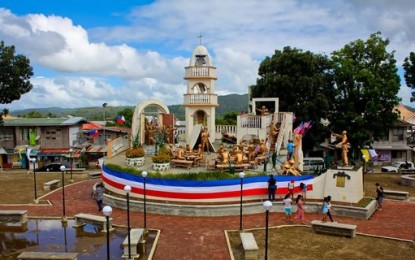
HISTORIC TOWN. The Balangiga marker in Balangiga, Eastern Samar. The town thanked President Rodrigo Duterte for making the Balangiga bells as a symbol of US-Philippine relations in his final State of the Nation Address. (Photo courtesy of Department of Tourism)
TACLOBAN CITY – The town of Balangiga, Eastern Samar thanked President Rodrigo Duterte for making the Balangiga bells as symbols of US-Philippine relations in his final State of the Nation Address (SONA).
Mentioning the bells in the President’s speech will surely spark the interest of many Filipinos about their town and draw more visitors, said Fe Campanero, Balangiga municipal tourism officer.
“We are the only place in Eastern Visayas mentioned in the President’s SONA. This is a big help to raise people’s awareness about the Balangiga bells and their role in our history,” Campanero said in a phone interview Tuesday.
On Monday, Duterte said in part of his speech that the Philippines welcomed back the bells of Balangiga after many decades "because a historic wrong needed to be corrected."
He told the audience that former American soldiers visited him to ask him whether he would accept an invitation by then-president Donald Trump to visit the US. "I said, 'No.' 'Why?' I said, 'I do not like the way that you are treating my country,'" Duterte said.
"And there was the clamor now of Balangiga. You return the bells of Balangiga. That's a war really sacred also to the soldiers. Then it is more sacred to us in addition to the religion -- the Roman Catholic Filipinos -- the Church," he added.
Duterte said he told former soldiers that he would consider visiting the US if the bells are returned to the country. The President said he eventually refused to go to the US because he "lost time to do it."
"But in my mind, and the Americans might know it… There was never in my mind a trip to America. With regard to the Balangiga, I said, you massacred one barangay -- barrio then, women and children and all, they were all killed because that bell, Balangiga, was used to call the people for prayers," he added.
Campanero said the President has played a “very important role” to fast-track the return of bells from the US although there were already efforts done to negotiate for its return.
Balangiga town is known for the Balangiga Encounter that happened on Sept. 28, 1901, when residents, led by Valeriano Abanador, initiated an attack against US soldiers.
The villagers killed 54 American soldiers using bolos. It was the biggest defeat of the foreign troops during the Philippine-American war.
In retaliation, the US soldiers attacked the town, killing anyone who could carry firearms and took the Balangiga bells.
“The Americans kept the story of their defeat in Balangiga as secret, but now this story is told to many Filipinos, especially that this was mentioned in the President’s SONA,” Campanero added.
The US government finally agreed to return the bells in August 2018 when US Defense Secretary James Mattis signed an official document agreeing to deliver back the wartime artifacts. The bells arrived in Manila on Dec. 11 that same year.
Duterte witnessed on Dec. 15, 2018 the turnover of the Transfer Certificate of the Balangiga Bells from US Deputy Chief of Mission John Law to Philippine Department of National Defense Secretary Delfin Lorenzana. The certificate was then handed over to the local government of Balangiga.
More than two years after the return of Balangiga Bells, the town of Balangiga in Eastern Samar continues to reap the benefits from this historic event.
Balangiga, a fourth-class town in Eastern Samar, is located 97 kilometers east of Tacloban City, the regional capital. The farming and fishing town has a population of over 14,000 as of 2020. (PNA)
